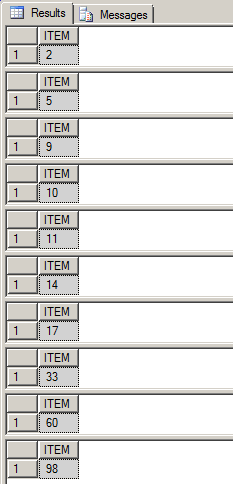Following Stored Procedure loop through the Table Variable and Prints it in Ascending ORDER. This example is using WHILE LOOP.
CREATE PROCEDURE PrintSequenceSeries
-- Add the parameters for the stored procedure here
@ComaSeperatedSequenceSeries nVarchar(MAX)
AS
BEGIN
-- SET NOCOUNT ON added to prevent extra result sets from
-- interfering with SELECT statements.
SET NOCOUNT ON;
DECLARE @SERIES_COUNT AS INTEGER
SELECT @SERIES_COUNT = COUNT(*) FROM PARSE_COMMA_DELIMITED_INTEGER(@ComaSeperatedSequenceSeries, ',') --- ORDER BY ITEM DESC
DECLARE @CURR_COUNT AS INTEGER
SET @CURR_COUNT = 1
DECLARE @SQL AS NVARCHAR(MAX)
WHILE @CURR_COUNT <= @SERIES_COUNT
BEGIN
SET @SQL = 'SELECT TOP 1 T.* FROM ' +
'(SELECT TOP ' + CONVERT(VARCHAR(20), @CURR_COUNT) + ' * FROM PARSE_COMMA_DELIMITED_INTEGER( ''' + @ComaSeperatedSequenceSeries + ''' , '','') ORDER BY ITEM ASC) AS T ' +
'ORDER BY T.ITEM DESC '
PRINT @SQL
EXEC SP_EXECUTESQL @SQL
SET @CURR_COUNT = @CURR_COUNT + 1
END;
Following Statement Executes the Stored Procedure:
EXEC PrintSequenceSeries '11,2,33,14,5,60,17,98,9,10'
The result displayed in SQL Query window is shown below:
![The Result of PrintSequenceSeries]()
The function PARSE_COMMA_DELIMITED_INTEGER() that returns TABLE variable is as shown below :
CREATE FUNCTION [dbo].[parse_comma_delimited_integer]
(
@LIST VARCHAR(8000),
@DELIMITER VARCHAR(10) = ',
'
)
-- TABLE VARIABLE THAT WILL CONTAIN VALUES
RETURNS @TABLEVALUES TABLE
(
ITEM INT
)
AS
BEGIN
DECLARE @ITEM VARCHAR(255)
/* LOOP OVER THE COMMADELIMITED LIST */
WHILE (DATALENGTH(@LIST) > 0)
BEGIN
IF CHARINDEX(@DELIMITER,@LIST) > 0
BEGIN
SELECT @ITEM = SUBSTRING(@LIST,1,(CHARINDEX(@DELIMITER, @LIST)-1))
SELECT @LIST = SUBSTRING(@LIST,(CHARINDEX(@DELIMITER, @LIST) +
DATALENGTH(@DELIMITER)),DATALENGTH(@LIST))
END
ELSE
BEGIN
SELECT @ITEM = @LIST
SELECT @LIST = NULL
END
-- INSERT EACH ITEM INTO TEMP TABLE
INSERT @TABLEVALUES
(
ITEM
)
SELECT ITEM = CONVERT(INT, @ITEM)
END
RETURN
END

